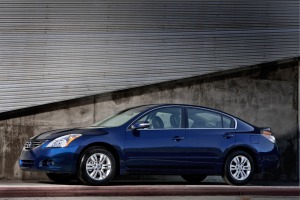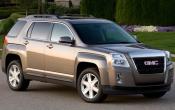
If you've been shopping for replacement tires recently, you've probably noticed a new emphasis on fuel-efficiency and environmental impact. Although the rubber itself is still black, tires are becoming significantly greener. Although only now are people becoming aware of them, development of low-rolling-resistance (LRR) tires began in the 1990s, once automakers had gone after much of the low-hanging fruit (e.g., vehicle weight, engine efficiency and aerodynamics) in the fuel-economy game.
Unfortunately, there is no easy way for consumers to navigate all the "greenery" currently sprouting up in the world of replacement tires. Even worse, most consumers are unaware of the possible trade-offs involved, including wet traction performance. So which green tires are right for your car?
If your vehicle came from the factory with LRR tires, simply insist on the original equipment (OEM) tires, which are typically available from the dealer as well as online and local tire retailers. If you're looking to make the switch to LRR tires, the answer isn't so straightforward. There are performance trade-offs that can come with LRR tires, and for us to explain those properly, a little physics lesson is in order.
Hard To Resist Simply put, rolling resistance is the force required to keep your vehicle's tires rolling at a given speed. Tire manufacturers quantify it by rolling a tire against a large cylindrical drum and measuring the forces involved to come up with a tire's rolling resistance coefficient (RRC).
An engineering degree is not required to understand that tires change shape as they rotate. The portion of the tire in contact with the road is deformed before it returns to its relaxed state. The energy required to deform a tire is greater than what's needed to return it to its original shape — a phenomenon known as "hysteresis." This energy is dissipated in the form of heat, and this plays a major role in rolling resistance.
If you've ever pedaled a bicycle with an underinflated tire, you have firsthand experience with hysteresis. To cruise at a constant speed, you had to put more mechanical energy into the system (pedal harder) than if the tire had been inflated to its proper level. That's because underinflated tires have lots of hysteresis, and thus create more rolling resistance.
So, if underinflated tires have high rolling resistance, then why not simply overinflate them to reduce their rolling resistance? That works, but there's a price to pay. For one thing, the ride quality suffers, becoming increasingly harsh as tire pressures rise. More importantly, the higher the pressure, the smaller the contact patch between your tires and the road surface. Less contact patch means less traction, which translates to decreased braking and cornering performance, especially on wet surfaces.
Resistance Is Futile To squeeze every bit of rolling resistance out of a given tire, engineers have several options. Reducing a tire's "footprint" (the contact area between the tire and road) is perhaps the most obvious, but has the undesirable consequence of reduced traction. A tire's composition also plays a factor, and the recent addition of silica to the typical mix of natural and synthetic rubbers has decreased rolling resistance without sacrificing traction.
Reducing the depth of the tread blocks is another fuel-saving tactic. The deeper they are (imagine a set of beefy off-road truck tires), the more they tend to flex as they go down the road — good for grip but bad for fuel economy, tire life and road noise. Sidewall design can help, as stiffer sidewalls tend to reduce rolling resistance, but this also increases mass, which can hurt rolling resistance.
Where the Rubber Meets the Road Of the energy stored in your gas tank that actually makes it to the wheels, much of it is used to overcome inertia (acceleration and deceleration) and aerodynamic drag. Around town, your tires' rolling resistance uses up about 4 percent of that energy, and approximately 7 percent when on the highway. How does this translate to fuel economy and dollars and cents? A long-established rule of thumb holds that a 10 percent decrease in rolling resistance yields a 1-2 percent improvement in fuel economy.
One or 2 percent doesn't sound like much, but it can add up. According to the Transportation Research Board, Americans drive an average of 12,000 miles each year, consuming 600 gallons of fuel in the process. If gas were $2.50 per gallon, that 1-to-2 percent saving would translate to $15-$30 each year. Over the three-to-four-year lifespan for a set of tires, this can mean $45-$120 in fuel savings, something to think about next time you're in the market for a new set of tires.
For automakers, that 1-2 percent improvement is far more valuable. Even a slight bump in fuel economy on a volume-selling model (say, the Toyota Corolla) can go a long way toward bringing up its Corporate Average Fuel Economy (CAFE), helping the automaker avoid costly government fines. CAFE forces automakers to think seriously about the rolling resistance of their OEM tires, but replacement tires rarely receive the same scrutiny.
Federal Involvement For replacement tires, even for a given tire type and size, the range of RRC is considerable, sometimes 25 percent spread between the low and high end, possibly translating into a 5 percent difference in fuel economy between otherwise similar tires. Work out all the math and you'd come up with a potential annual fuel savings of $75, which you can double when gas prices once again approach the $5-per-gallon mark.
Unfortunately, consumers don't currently have a way of knowing a tire's RRC. Current tire labeling required for traction and wear ratings is of little help here. "Hard" tires that last longer do not necessarily have lower rolling resistance, and a higher traction rating doesn't always correspond to higher rolling resistance. What's a well-intentioned consumer to do? Help is on the way (brace yourselves) via the government, with pending legislation aimed at better informing consumers about tire issues.
In California, the effort is being pushed by the California Energy Commission. "The commission has completed testing a number of tires to determine their fuel-efficiency," says CEC Information Officer Adam Gottlieb, "and is now in the process of developing the rules and regulations that will mandate that tire manufacturers report the fuel-efficiency of all passenger and light truck tires for sale in California."
More than likely, this will mean some form of labeling affixed to the tires, along with plenty of supplemental materials, including placards displayed at retailers, public awareness campaigns, online databases of RRC, etc. There are plenty of details yet to be worked out, but Gottlieb is optimistic. "By December 2009," he says, "we expect to have minimum efficiency standards for tires sold in California." And, as is often the case with environmental issues, the rest of the country is expected to follow California's lead.
Performance Compromise Many tire makers welcome the labeling of rolling resistance on tires, although there is widespread concern that oversimplified labeling (comparisons are often made to the Energy Star ratings commonly seen on household appliances) would misrepresent the complexities of tire performance. If the labels focus solely on fuel economy and/or environmental benefits, consumers might overlook other important performance aspects — wet braking performance, for example.
"You need to be able to provide information about the overall compromise," suggests Forrest Patterson, technical director for passenger car and light truck tires in North America with the Michelin Americas Research Center. "The more that we can inform consumers and provide information for them about that, the better the choices they are going to make."
Our own testing of vehicles equipped with both "regular" tires and LRR tires has often revealed performance differences in terms of handling and stopping distances. The 2009 Chevy Cobalt XFE, 2008 Lexus RX 400h and 2009 Toyota Prius come to mind. This is why so many are pushing for the labeling to go beyond fuel-economy ratings, and include "information about the overall compromise," as Patterson puts it. Such a labeling program would go a long way toward helping consumers make an informed decision.
Roll With It When it comes to buying replacement tires, the advice is the same regardless of whether you're looking for LRR tires or "regular" rolling stock. For the vast majority of us, the tires that came from the manufacturer are often the way to go, as they have undergone extensive testing on that particular vehicle. Those of us who simply can't leave well enough alone, or insist on entering our Prius in the weekend autocross, should be sure to do our homework.
Presumably, once labels are introduced, this task should become easier. For now, consider online communities such as our CarSpace forums, and useful resources such as Tire Rack, which beyond the usual sizing information and pricing, provides extensive test results and customer reviews. Being aware of the trade-offs between fuel economy and tire performance will make you a more savvy tire shopper. So when the time comes for replacement tires, even a novice can feel a little less, well, green.













